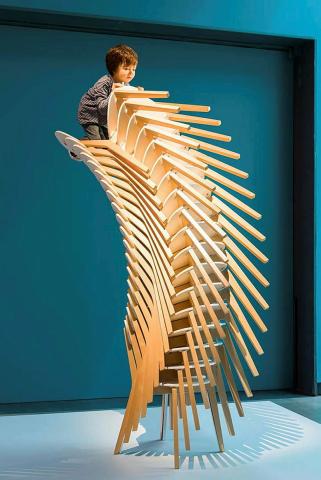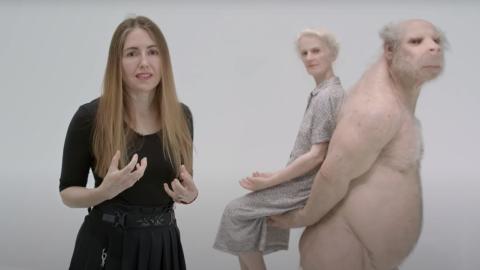Piccinini’s Metamorphosis and The Observer
By Peter McKay
July 2018
Patricia Piccinini’s Teenage Metamorphosis 2017 makes a playful literary reference to Franz Kafka’s best-known short story The Metamorphosis. As fantastic and future-minded as Piccinini’s works often appear, many of the underlying scenarios are in fact inspired by her own experiences, and in this instance she draws not only on her own reading, but on her son’s transformation from a child to a young adult. That said, Piccinini also courts ambiguity and multiple readings, making for an enigmatic experience and thoughtful engagement. In this work, the viewer is unsure if the metamorphosis referred to in the title is that of the young man’s physical maturation, a humorous nod to his intellectual awakening through cultural content, or the obvious genetic transformation that he has undergone. He body reveals that he has apparently incorporated animal DNA, perhaps that of a pig, into his own — though he also exhibits another level of sculpted genetic mutation to express the patterns of a sneaker sole in his back.

Patricia Piccinini’s Teenage Metamorphosis 2017 (foreground), with glimpses of The Bond 2016 (Courtesy: The artist) and The Field (Planting) 2018, ‘Curious Affection’, GOMA, March 2023 / © Patricia Piccinini / Photograph: N Harth, QAGOMA
Piccinini’s interest in sneakers, and shoes generally, stems from a recognition of the ways in which designers stir our latent desires and emotions through shapes, patterns, colours and textures. In fact, design contributes so much to our everyday experience of the world that we, the viewer, might not see this young man’s augmentation to be as strange as it obviously is. Consumer desire, stoked by sophisticated design, is such a significant part of our experience of the world. It could be that his ‘tread’ also has some other very specific protect purpose for an intended future vocation, but its utility is not as obvious as the suggestion of fashion.
The Observer 2010 is by comparison a less complicated gesture, and functions somewhat uncharacteristically by the lifelike quality of her silicone sculptures. Poised atop a dangerously tall stack of stylishly modern chairs, a young boy without any discernible genetic modification peeps down at his audience. The first moment of encounter is startlingly effective. It prompts an immediate reflex to act in ways that might protect and assist the child. Cutting through all questions of how he got there, and who or where his guardian might be, this work makes tangible the implicit collective and responsibility that we have to the young and vulnerable.

Patricia Piccinini’s The Observer 2010, installed for ‘Curious Affection’, GOMA, March 2023 / © Patricia Piccinini / Photograph: N Harth, QAGOMA
In a quieter way, however, The Observer also tells of our collective responsibility for future generations. Sitting at a remove, the boy gains some distance on the world, and perhaps observes all the extraordinary way in which we continue to create change, both intentional and unintentional, through science, technology, and perhaps our broader values too. It is certainly much more difficult to identify the long-term consequences of small and incremental actions on future generations than it is to discern an immediate danger, yet the delicate connection that the artist draws here goes a long way to illustrating the necessity of responding to increasingly visible social and environmental dilemmas.

The Observer 2010
- PICCININI, Patricia - Creator
Digital story context and navigation
PATRICIA PICCININIExplore the story



